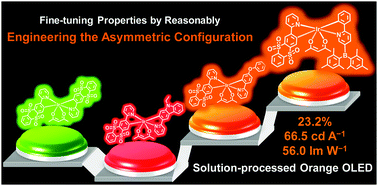Towards high performance solution-processed orange organic light-emitting devices: precisely-adjusting properties of Ir(iii) complexes by reasonably engineering the asymmetric configuration with second functionalized cyclometalating ligands†
Abstract
The property-tuning of phosphorescent organometallic Ir(III) complexes is a crucial issue in developing high performance electroluminescent materials. Unlike the conventional strategy that usually regulates the properties of symmetric tri-/bis-cyclometalated Ir(III) complexes by modifying the structure of the cyclometalating ligands, we herein report the method of tuning properties by reasonably engineering the asymmetric configuration of Ir(III) complexes. Taking the newly synthesized conventional symmetric bis-cyclometalated Ir(III) complex SIrS as a reference, the emission properties such as the emission color, radiative lifetime (τr), and the photoluminescence quantum yield (PLQY) as well as charge transport properties can be tuned step by step by reasonably choosing the second functionalized cyclometalating ligand. The photophysical measurements and theoretical calculations reveal that the adjustment of emission properties results from the switches of the low energy charge transfer characteristics. Accordingly, the optimized asymmetric complex SIrB displays the highly desirable orange emission with a high PLQY of 0.96, a short τr of 0.38 μs, and significantly enhanced electron injection/transport abilities. More importantly, the solution-processed orange organic light-emitting device (OLED) based on SIrB exhibits excellent electroluminescence (EL) performance with a maximum external quantum efficiency (EQE), current efficiency (CE), and power efficiency (PE) of 23.2%, 66.5 cd A−1, and 56.0 lm W−1, respectively, which are among the best reported for state-of-the-art solution-processed orange OLEDs. This study demonstrates the importance of the asymmetric configuration engineering strategy for developing phosphorescent Ir(III) complexes with outstanding EL performance.



 Please wait while we load your content...
Please wait while we load your content...